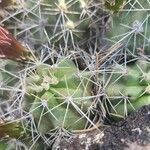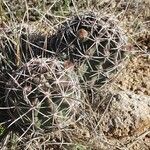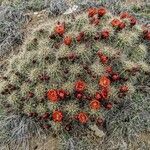A cactus. It forms clumps or clusters. It grows 30-40 cm high and spreads 20-50 cm wide. The stems are cylinder shaped and can be 15-20 cm long. They are 5 cm wide. They can occur singly or in clumps. They have about 10 ribs. They have short spine in a ring around a central spine. This central one can be 7 cm long. The flowers are red and long tubes. They can be 5 cm across. Some different varieties occur. The fruit is round and pink or red. It has spines which fall off.




